
The Twitter account named EAFJD has posted a tweet with this text: "33 years ago state-sponsored pogroms of Armenian population in Baku were organized by Soviet Azerbaijan. Armenians were beaten, murdered and expelled. More than 200K Armenians were forcefully expelled from Baku. The tweet includes a famous photo well known to Azerbaijanis and the leaders of the European Union, the head of the Committee on Foreign Relations and Security Policy of the European Union, the vice-president of the European Commission Josep Borrel, the special representative of the EU for the South Caucasus Toivo Klaar (@ToivoKlaar), the president of the European Commission Ursula von der Leyen (@EU_Commission), the President of the Council of Europe Charles Michel (@CharlesMichel), S&D Group, Renew Europe , EPP Group, ECR Group, Greens/EFA in the EU Parliament.
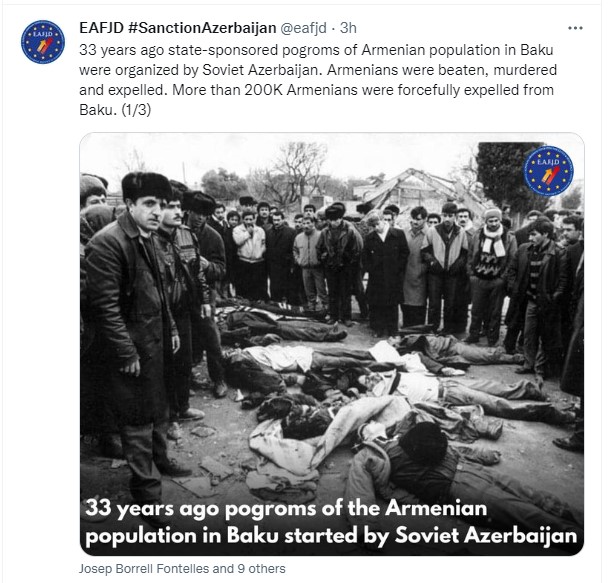
Faktyoxla Lab has conducted a fact-check for foreigners about the photo attached to this post and the information in the tweet in general.
First, about the author of the tweet. EAFJD - European Armenian Federation for Justice and Democracy is one of the main activity centers of the Armenian lobby. Although its primary goal is to strengthen relations between the European Union and Armenia, it is more about doing business against Azerbaijan and Turkiye with black PR and money laundering methods. In 2013, a friendship group with Armenia "European Friends of Armenia" (EuFoA) was established in the European Parliament. After the European Parliament elections in 2014, the composition was changed. Currently, there are 50 European MPs in the group.
The head of the organization is Armenian billionaire Kaspar Karampetyan, whose name has been involved in many scandals. More information about this person can be obtained from these sources - (source1) (source2). Let's just remind that Karampetyan is the sponsor of the five deputies named in the investigative actions called "Qatargate" launched against the members of the European Parliament on December 9, 2022.
Now back to the tweet.
First, about the events that took place in Baku on January 13-15, 1990.
If the foundations of the collapse of the USSR were laid in 1987, 1988 was marked by the first nailing of the coffin of the Soviet Union. Experts estimate that in 1988, when the collapse of the USSR began, there were about 20 conflict zones in the country. The most resonant of these was the discussions around Nagorno-Karabakh. (Alexander Yakovlev. Perestroika: 1985—1991. M., International Foundation "Democracy", 2008. P.182). In February 1988, the separatist tendencies in the Nagorno-Karabakh Autonomous Oblast reached its climax, and in particular the decision of the regional council to annex Nagorno-Karabakh to Armenia brought the tensions to their highest point. Assessing the events in Stepanakert (Khankendi), Gorbachev, the secretary-general of the Central Committee of the Communist Party of the Soviet Union, admitted at a meeting of the Politburo that "the impulse comes from Armenia." (Session of the Politburo: on events in Azerbaijan and the Armenian SSR.29.02.1988.//The National Security Archive at the George Washington University. Doc. 13152, p.89). However, practically nothing was being done to prevent this "impulse", and Moscow was even protecting separatist demands of the Armenians sometimes presenting them as "a show of openness and pluralism."
First, on February 28, 1988, the events in Sumgait took place under the direct organization and management of the Soviet special services. The killing of 26 Armenians and 6 Azerbaijanis in these events (the riots were organized by the Armenian Eduard Grigoryan and proved by the facts that he showed to) turned the national confrontation into an irreconcilable level.
In the autumn of the same year, Azerbaijani refugees expelled from the Nagorno-Karabakh Autonomous Oblast were added to the Azerbaijani refugees expelled from the Armenian SSR. (During those events, 70 Azerbaijani civilians were killed in the Gugark region of Armenia alone). Under the wave of refugees, the republic was in chaos. On December 1, 1989, the decision of the Supreme Soviet of Armenia "On the annexation of Nagorno-Karabakh to the Armenian SSR" removed the situation in Azerbaijan from the control of the Soviet authorities.
On the evening of December 31, the Soviet Union border facilities with Iran and Azerbaijan along the Araz River were destroyed on a 137-kilometer territory. Azerbaijanis living on both banks of the Araz crossed the river and met. Interestingly, the full-fledged border troops were indifferent to the incident and did not interfere in the destruction of the border with Iran by the Azerbaijani SSR.
Since the beginning of the conflict, 185 Azerbaijani villages have been destroyed in Armenia, 230,000 people have been expelled, 31,000 houses, 165 collective and state farms have been looted, 216 Azerbaijanis have been killed and 1,154 injured, mainly in Gugark and Masis districts.
Upon his arrival in Baku, Andrei Girenko, secretary of the Central Committee of the Communist Party of the Soviet Union, held a meeting in the republican party organization on January 6, 1990 and announced Moscow's position. On the same day, at the same time as the meeting in the Central Committee, the third congress-authorized conference of the Popular Front began in the building of the Academy of Sciences of the Azerbaijan SSR. A new board of 14 people, led by Abulfaz Aliyev (Elchibey), mainly representing the liberal camp within the movement, was elected. However, supporters of the radical line within the movement do not agree with this, and at a rally on January 13, information was announced about the establishment of the National Defense Council. Although the chairman of the council was Abulfaz Elchibey, the other four members (Etibar Mammadov, Nemat Panahov, Khalig Bahadur, Rahim Gaziyev) were directly radicals. "In essence, this meant declaration of a parallel power structure. He took control of the situation on the ground by armed resistance to the Armenian aggression. (Agayev R., Ali-zade Z. Azerbaijan. The end of the second republic (1988–1993), p.166).
During the rally, there were reports of Armenian looting in Baku and the failure of the authorities, especially the police, to intervene. After the looting began, Liskauskas, the USSR deputy interior minister in Baku, did not allow the use of the 12,000 personnel of the Internal Troops stationed in Baku against the looters and responded very briefly to the criticism: "Resolve the issue with Moscow. I need instructions and additional forces to establish order." (Huseynov Vagif. More than one life. Second book, p. 276).
During the events of the night of January 13-14, 32 people of Armenian descent were killed. The fact that the authorities, especially the internal troops in Baku, did not try to prevent the killings was a sign of Moscow's intention. "On the evening of January 13, 1990 and on the night of January 14, 1990, there were cases of violence against the Armenian population in different parts of Baku. The next day there were also small-scale crimes. According to official data, 32 Armenians were killed in two days. There are also victims among Azerbaijanis…Preliminary investigation of the facts shows that the crimes were committed by special people who immediately disappeared from the scene. This shows that these people were prepared in advance. What forces are behind them, who is the organizer?" (Balayev Aydin, Rasim Mirza. January 20 events. Documents, positions, comments. Baku, 2000. P.56-57). It was a fact that the events were organized by the forces that wanted to declare a state of emergency in Baku.
Thus, mass looting, murders and robberies took place in Baku. The city was in turmoil. All this slowed down in the following days - on January 18-19, and stopped completely. This savagery, violence, death and robbery took place in front of the troops of the USSR Ministry of Internal Affairs, the State Security Committee of Azerbaijan and the Ministry of Internal Affairs in Baku at that time. All this was a sign of a cunning game. Authorities and power ministries were content to watch the looting, destruction and chaos. The flow of information sent to Moscow shows that the situation in Baku is uncontrollable and they are asking for help. In fact, it had one purpose: to send troops to Baku...
On the night of January 19, a state of emergency was declared in Baku without the knowledge of the people, and on January 20, a massacre was committed in Baku. All this suggests that the looting that took place in Baku on January 13-15 was organized by the USSR State Security Committee and officials of Armenian origin to lay the ground for the incursion of troops into Baku a week later.
Now about the shared photo.
It is interesting that not only EAFJD, but also other Armenian users continuously present the tragic events that happened in Azerbaijan under their name, as if they happened to them, and easily deceive the readers who are unaware of the realities.
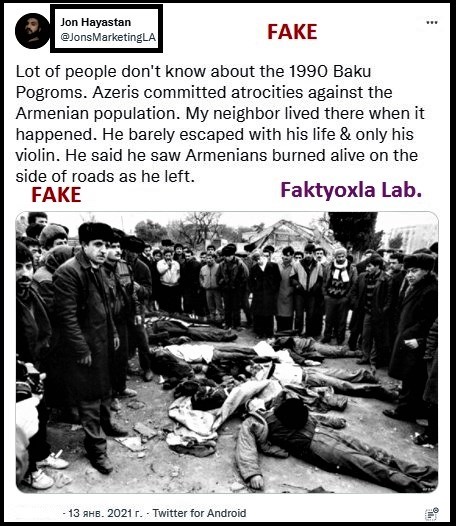
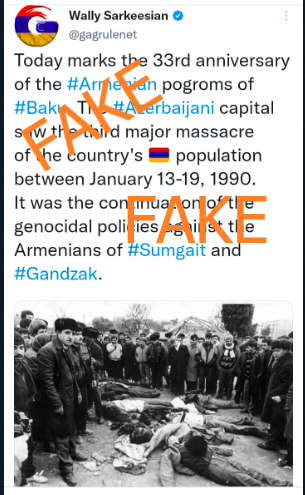
In fact, these photos were taken on January 21, 1990, in Baku. The author of the image is Azerbaijani photographer Asim Talib.
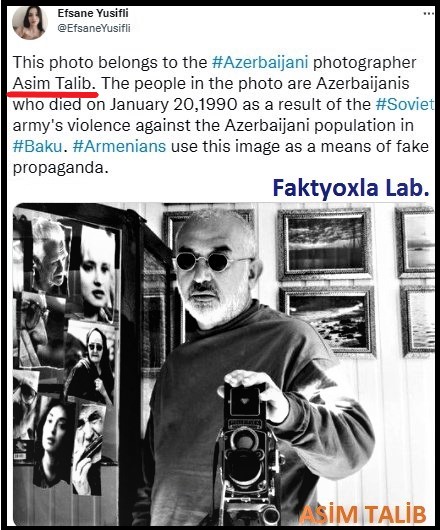
We have obtained this information about the young man seen in that photo. His name is Aladdin, and he worked as a taxi driver in the 2nd "Taximotorny" office. He is originally from the Amasiya district of the Armenian SSR.
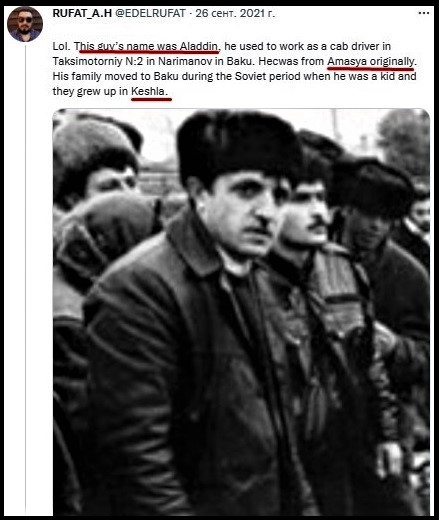
Armenian sources attribute this photo not only to the events of January 13-15, 1990, but also to the "Sumgait provocations" organized by the Central Committee of the USSR and Armenian nationalists in 1988. Source1, Source2, Source3
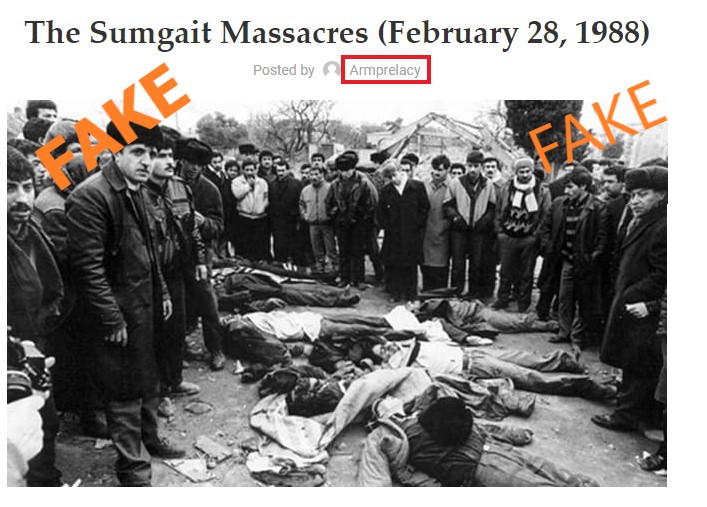
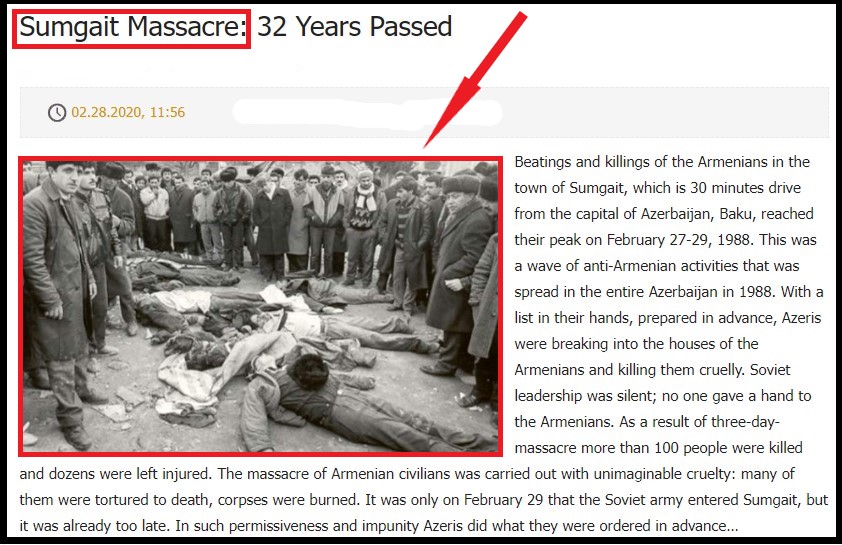
Result:
The information shared on the Twitter account of the EAFJD- European Armenian Federation for Justice and Democracy is false, and the photo's attribution to "Baku looting" is a lie. The photo was taken by an Azerbaijani photographer in Baku on January 21, 1990.




















